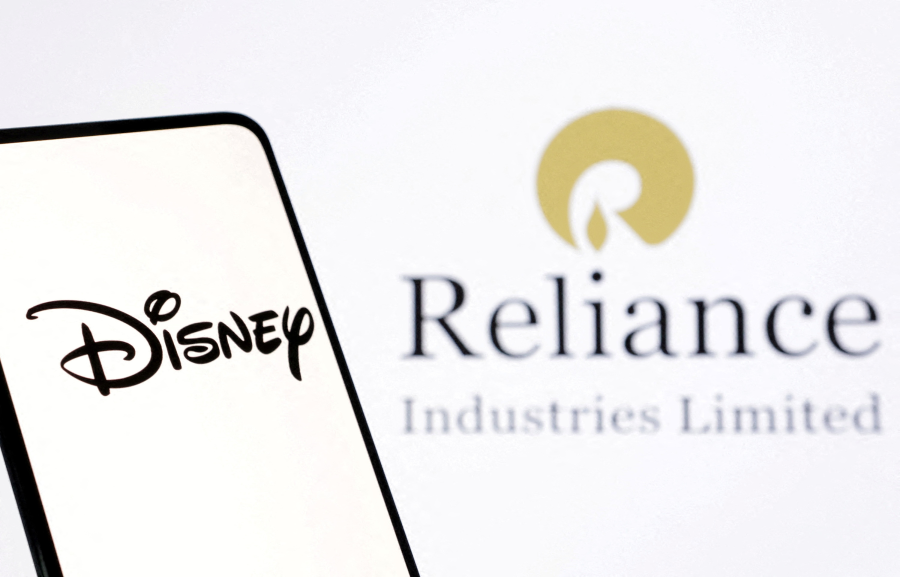
The proposed stock and cash media and entertainment mega-merger between Disney’s India business and Indian billionaire Mukesh Ambani’s Reliance’s media unit Viacom18 is now in its final stages, with antitrust due diligence reportedly underway.
The leaders of both media giants signed a binding agreement in February, which will give Ambani’s company a controlling interest in the combined entity. The Economic Times report said that the acquisition is likely to take place with Reliance setting up a new subsidiary, which will absorb Disney’s Star India through a share swap deal. The deal also includes Reliance’s over-the-top (OTT) platform JioCinema, and Disney’s loss-making OTT service Hotstar.
Once finalised, the deal is likely to create the largest player in India’s $28 billion media and entertainment market. Competition expected from the earlier approved media merger between Zee Entertainment and Sony India also looks to be in the rearview mirror, with the deal falling out and parties engaged in dispute resolution.
But its not time to sing Hakuna Matata just yet, as the deal will face tough antitrust scrutiny from India’s antitrust watchdog, The Competition Commission of (CCI), and may have to offer divestment of certain assets before final approval, legal experts say.
Both Reliance and Disney have law-yered up for this stage, with the former instructing Khaitan & Co and Shardul Amarchand Mangaldas, and the latter seeking guidance from AZB & Partners.
WHAT ARE THE CCI’S POTENTIAL CONCERNS SURROUNDING THE DEAL?
While dominance by itself is not anti-competitive, its effect on competitors and its reliance on vertical markets is a major concern for the CCI.
“Both parties are present across the entire value chain of the broad-casting industry, which comprises content production and aggrega-tion, broadcasting and content dis-tribution etc. Accordingly, the CCI would look at the combined market presence of parties and the level of competition in (i) wholesale supply of TV channels including in different genre like Hindi entertainment, Marathi, Bengali etc. (ii) OTT platform (iii) Supply of advertising airtime on TV channels and (iv) Production and supply of films to third-party distributors and exhibitors for theatrical release, etc,” says Vaibhav Choukse, head of the competition practice at J. Sagar Associates. Reliance and Disney, each have
a major streaming service as well as 120 TV channels between them. As per the CCI’s records from 2022, Dis-ney and Reliance’s Viacom held up to 50 percent of the general entertainment channel (GEC) TV market in India, including up to 50 percent of Hindi GEC, up to 55 percent of Marathi GEC, up to 50 percent of Bengali GEC and up to 35 percent of the Hindi film market.
Competition concerns around the deal, like those analysed by the CCI in the Zee-Sony merger approved by the commission in 2022, centre on the effect of the creation of a dominant market player on the downstream market.
“The assessment of CCI would focus on the effect of the deal on stakeholders such as viewers, advertisers, content producers, distributors, etc. as parties will become the largest broadcasting house in India with over 100 TV channels, making them an indispensable partner to downstream players, particularly Distribution Platform Operators (DPOs) and advertisers,” Choukse says.
WHY IS A SINGLE SPORT SUCH A BIG FACTOR IN THE DEAL?
Another market where the combined entities will exercise almost monopoly power is the broadcasting of India’s favourite sport, cricket. The nation of 1.4 billion people is widely reported to account for around 80 percent of cricket’s global revenues, much of which comes from TV advertising.
Disney’s Star has exclusive rights over the broadcast of the Indian national teams’ matches – as well as most of the domestic com-petitions – in India while Reliance’s Jio has rights to the cricket-fanatic country’s biggest cash cow, the Indian Premier League tournament. “In terms of preference, major-ity of Indian viewers watching cricket or major cricket event would not switch to another sports event like Wimbledon, even if two were broadcast at the same time. From the broadcaster’s perspective, the viewers and advertising revenue generated from cricket is unparallel to any other sport in India. The CCI would be interested in examining if the ‘combined entity’, due to its strong market presence in cricket streaming/ TV broadcasting, can command exorbitant advertis-ing rate, leaving advertisers with-out bargaining power,” explains Choukse.
“CCI would also be keen to examine the licensing terms as an excessively long duration and over-board scope may exclude competing broadcasters from access to attractive content,” he adds.
WHAT ARGUMENTS FAVOUR THE DEAL?
The lawyers supporting the merger can argue that TV channel distribu-tion is heavily regulated by the Tele-com Regulatory Authority of India at both wholesale and retail levels. The new entity will not have the ability to engage in discriminatory and dif-ferential pricing/ treatment vis-a-vis downstream partners such as DPOs due to TRAI’s regulations prohibit-ing any differential or discriminatory pricing/ behaviour, says Choukse. “The parties can also showcase the trend of new players entering the market, leading to decline in their market shares and significant movement of viewers switching to OTT apps,” Choukse adds.
On advertising concerns, the parties may submit that advertising agencies and advertisers exert coun-tervailing buying power and can eas-ily switch to other competitors. Also, advertising agencies and advertisers have the ability to switch to digital and other forms of advertising, with more advertisers increasingly shifting towards digital advertising.
“In case of CCI concern, the merged entity could offer com-mitments to not raise ad rates or decrease airtime, for a certain period,” Choukse adds.
The CCI’s approval of a similar Zee-Sony merger in 2022 lays a solid precent in favour of the Disney-Reli-ance deal. Even that approval only came after the parties volunteered remedies to ease competition concerns, including a commitment to divest control in certain TV channels, including Zee Action, Zee Classic and Big Magic.
Similar commitments may have to be made by the new Reliance-Disney entity in order to obtain the CCI’s approval.
But the fallout of the Zee-Sony merger also simplifies things for the deal. “But with the merger called off, Disney-Reliance faces one less major competitor, potentially weakening the argument against the merger on competition grounds,” Choukse says.
That said, “the sheer size of the Disney-Reliance merger could still attract significant scrutiny from regu-lators, especially considering exist-ing concerns about media concen-tration in India,” Choukse warns.


